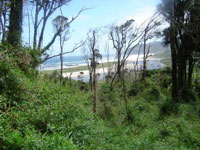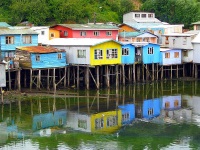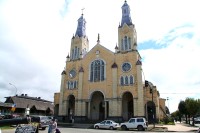Isla Grande de Chiloe Travel Guide
Chiloe is South America's largest island, 112 miles (180km) long and 37 miles (60km) wide. It is a wild and beautiful place but also one of Chile's poorest areas, with most of the populace scratching a living out of farming or fishing. It has rich folkloric traditions, though, and a wealth of mythology that has contributed to Chilean literature, involving trolls, sea monsters and ghost ships. Another mark of the unique Chilote culture is the distinctive craftwork that is produced, especially that made from wool.
The island's rich heritage is evident in its unique architecture: the forested countryside is scattered with more than 150 wooden churches dating back more than two centuries; the estuaries are lined with quaint palafitos (stilted houses); and the small towns feature wooden shingled buildings. Most of the Chilotes live within sight of the sea and scenes of colourful wooden boats are commonly visible through the rain and mist. Seafood is a prominent part of daily life here and the morning's freshest catch is always available at local restaurants and markets.
Known for damp weather and spooky folklore that is perfectly suited to the island's misty beauty, Chiloe balances wild nature with the warmth of its people and their culture. As it is still largely an unknown destination, a visit to the island offers adventurous travellers an authentic and unique experience of Chile, especially in the main town Castro, or in the wonderful national park on the pacific coast, Parque Nacional Chiloe.
Things to do in Isla Grande de Chiloe
This mystical island remains a reasonably undiscovered gem for travellers in Chile and there is still lots to discover. The island has remained remote and isolated for centuries and, as a result, has retained a unique and intriguing culture with a rich folklore that delights visitors. Although travellers may not find as many traditional tourist attractions here as they might in other regions, they will certainly be charmed by the landscape and culture of Isla Grande.
Castro, the capital, is quaint and colourful and just wandering the streets and taking in the unique architecture and culture is invigorating. There are several sightseeing attractions, including some great craft markets, the San Francisco Church, the regional museum and the MAM Gallery. As with many Chilean cities, the Plaza de Armas (central square) is a good starting point.
One of the most special attractions of Isla Grande de Chiloe is the collection of 17th-century wooden churches strewn about the island. These churches remain perfectly preserved and have been jointly declared a UNESCO World Heritage site. The architecture of these buildings is unique and their various settings are astounding and often quite spooky.
Isla Grande is also the base for excursions out into the archipelago and can be used as a pathway to a number of beautiful wilderness areas. The undisputed jewel among these is the nearby Parque Nacional Chiloe, which boasts stunning natural landscapes and a number of well-maintained hiking trails.

Parque Nacional Chiloe
Following in the footsteps of 19th-century English naturalist Charles Darwin, visitors will find an isolated but wildly beautiful landscape of rolling hills, native forests and pristine coastline in Parque Nacional Chiloe. It is home to the Chilote fox, the rare pudu (miniature deer) and over 100 species of birds, including the Magellanic penguin.
The park offers a variety of walking trails, through forests and under twisted tepu trees, along miles of unspoilt coastline or along nature trails that lead up onto the hills for superb views of the surrounding area. One of the draws of the hiking trails in Chiloe is the wide selection of short hikes, making it a good activity even for novice hikers, but there are also epic hikes for those who want to walk long distances. The park is also home to several Huilliche Indian communities, and visitors can find information about the traditions and folklore of the Huilliche people, as well as displays on the flora and fauna of the area.
This amazing wilderness area is only 18 miles (30km) west of Chonchi and 34 miles (54km) west of Castro, making it easily accessible. The area receives a huge amount of rain year round, so visitors should be sure to come prepared.

Castro
Founded in 1567, Castro is the main town (technically a city) on Chiloe Island and the third oldest city in Chile. It's famous for its colourful rows of palafitos (stilted houses) lining the estuaries, excellent seafood and traditional handicrafts. With an eclectic blend of Chilote culture and modern development, Castro is a popular summer destination for both Chilean and Argentinian tourists and has a laid-back feel to it.
One of the town's most interesting features is the San Francisco Church. Painted in dazzling pastel colours, it contains a number of other interesting attractions, including craft markets, the regional museum and the MAM Gallery. Castro also has a range of restaurants and shops, and a few bars to keep the fun going into the night. The central town square, Plaza de Armas, is the heart of Castro, where visitors will find a number of great eateries, as well as a prime people-watching position.
Cycling around the island is another popular activity and a good way to see the sights. The town is also a short hop away from the nearby islands of the Chiloe archipelago and the Parque Nacional Chiloe, which make for wonderful excursions.

Wooden Churches of Chiloe
The Spanish, who arrived in the 16th century, and Jesuit missionaries that came to Isla Grande de Chiloe in the 17th century, built hundreds of wooden churches in the archipelago in an attempt to 'civilise' the three local Indian tribes that occupied the islands. The Jesuits built more than 80 of these places of worship, and the Franciscan order later joined them and added to the region's astounding collection of chapels and churches. The 16 churches that still remain well preserved have been jointly UNESCO-listed. Visiting some of these old buildings is one of the most interesting things to see and do in Isla Grande de Chiloe.
Apart from being ancient, the churches have a unique architecture that makes them special; in fact, the whole archipelago benefits from its own style of building, which visitors find delightful. Although recognisably colonial in some ways, the mix between the local and European influences is unexpected and original to the area, possibly because isolation allowed the architectural style to develop largely undisturbed for centuries. The churches are wooden, often painted with the pastel colours associated with Castro.
Three of the most famous can be found in the villages of Chonchi and Dalcahue, and in Castro itself. They're a popular tourist attraction in Isla Grande de Chiloe, and those lucky enough to travel to this region should try to visit as many as possible.
Chile travel info
Electricity
Electrical current is 220 volts, 50Hz. Round two-pin plugs and round three-pin plugs are used.
Language
The official language is Spanish.
Money
The local currency is the Chilean peso (CLP), which is divided into 100 centavos. Visa, MasterCard, Diners Club and to a lesser extent, American Express, are accepted in most large shops and hotels. ATMs are widely available.
Tipping
Tips of about 10 percent are expected in restaurants; it's usual to round up the fare for taxi drivers if they help with the luggage. Tipping small amounts is customary for most services.
Health
All eligible travellers should be up to date with their COVID-19 vaccines; vaccinations for hepatitis A, hepatitis B are recommended, and a typhoid vaccine may be recommended for long-term travellers who plan to visit rural areas and eat outside of hotels and restaurants. Water is generally safe in the cities, but should be treated in the rural areas; bottled water is widely available for drinking. Santiago is severely polluted and this could cause respiratory problems or eye irritations, particularly between May and August. Travellers visiting the Andes Mountains should be aware of altitude sickness, and ascend slowly to allow the body to adjust. Healthcare in urban areas is generally good, but hospitals and clinics are expensive. Comprehensive travel health insurance is recommended.
Safety
Chile is a politically stable country with few safety threats to travellers. Incidences of pick-pocketing and mugging are on the increase in big cities and travellers should take care of their belongings, especially around tourist areas and bus stations. Travellers should also avoid walking alone late at night, and should be particularly cautious in Valparaiso and the capital, Santiago, where theft is on the increase, and muggings are becoming more common in popular walking areas such as Cerro San Cristobal, Cerro Santa Lucia and Cerro Manquehue. There has been an increase in reports regarding people receiving spiked drinks at nightclubs and bars, particularly in Santiago. Travellers should avoid any involvement in political protests and demonstrations, which take place from time to time. Chile has a landmine problem, which is mainly restricted to border areas adjacent to Peru and Bolivia. These areas are seldom visited by most travellers, so landmines shouldn't be a problem. However, visitors are advised to stick to marked roads, obey all signs and seek the advice of local authorities if travelling to these areas.
Local customs
Although Chile is largely conservative in outlook, homosexuality is legal and is increasingly widely accepted socially. Punishment for the possession and consumption of drugs is illegal and can lead to prison sentences.
Doing business
Chilean business culture tends to be formal, and this includes dress, which should also be conservative. In business, Chileans should be addressed by their titles and surnames, unless otherwise stated. Businesses are often family run. Third party introductions are indispensable when arranging a meeting, and developing a personal relationship is key. Chileans often stand very close when conversing and it is impolite to pull away. Visitors are also expected to re-confirm appointments before arriving at a meeting. Foreigners should be on time for meetings, but it is not unusual for the host to be 15 to 30 minutes late. On introduction, a firm handshake and exchange of business cards is usual; cards should be printed in both English and Spanish, and it's important to pay attention to the card before putting it away carefully. Business hours are generally 9am to 5pm Monday to Friday, often with a siesta over lunch.
Duty free
Travellers entering Chile do not need to pay customs duty on 400 cigarettes, 50 cigars (large or small) and 500g tobacco; 2.5 litres of alcohol; and perfume for personal use. Meat products, flowers, fruit and vegetables may only be imported if permission is given by the Department of Agriculture.
Communications
The international access code for Chile is +56. The outgoing code is 00 followed by the relevant country code (e.g. 0044 for the United Kingdom). Hotels, cafes and restaurants offering free WiFi are widely available. As international roaming costs can be high, purchasing a local prepaid SIM card can be a cheaper option.
Passport & Visa
A return or onward ticket is required, and it's recommend that passports be valid for six months after the intended period of travel. Extension of stay is possible for an additional 90 days for visa exempt visitors.
Entry requirements
No visa is required by US nationals for visits of up to 90 days, though a passport valid on arrival is required for travel to Chile. Travellers who visit Easter Island are allowed to stay for a maximum of 30 days.
UK nationals do not require a visa for visits of up to 90 days, though a passport valid on arrival is required. Travellers who visit Easter Island are allowed to stay for a maximum of 30 days.
No visa is required by Canadians for visits of up to 90 days; a passport valid on arrival is required for travel to Chile. Travellers who visit Easter Island are allowed to stay for a maximum of 30 days.
Australian nationals require a visa and passport valid on arrival. Travellers who visit Easter Island are allowed to stay for a maximum of 30 days.
South African nationals must hold a passport valid on arrival, though a visa is not required for stays of up to 90 days. Travellers who visit Easter Island are allowed to stay for a maximum of 30 days.
Irish nationals must hold a passport valid on arrival, but a visa is not required for a stay of up to 90 days. Travellers who visit Easter Island are allowed to stay for a maximum of 30 days.
New Zealand nationals must hold a passport valid on arrival, though a visa is not required for a stay of up to 90 days. Travellers who visit Easter Island are allowed to stay for a maximum of 30 days.
Useful contacts
Chile National Tourism Website: www.chile.travel
133 (Police); 131 (Medical)Embassies / consulates in other countries
Embassy of Chile, Washington DC, United States: +1 202 530 4104.
Embassy of Chile, London, United Kingdom: +44 (0)20 7222 2361.
Embassy of Chile, Ottawa, Canada: +1 613 235 4402.
Embassy of Chile, Canberra, Australia: +61 (0)2 6286 2430.
Embassy of Chile, Pretoria, South Africa: +27 (0)12 460 8090.
Embassy of Chile, Dublin, Ireland: +353 (0)1 667 5094.
Embassy of Chile, Wellington, New Zealand: +64 (0)4 471 6270.
Embassies / consulates in Chile
United States Embassy, Santiago: +56 (0)2 330 3000
British Embassy, Santiago: +56 (0)2 370 4100.
Canadian Embassy, Santiago: +56 (0)2 652 3800.
Australian Embassy, Santiago: +56 (0)2 550 3500.
South African Embassy, Santiago: +56 (0)2 8200 300.
Embassy of Ireland, Buenos Aires (also responsible for Chile): +54 11 5787 0801.
New Zealand Embassy, Santiago: +56 (0)2 616 3000.



